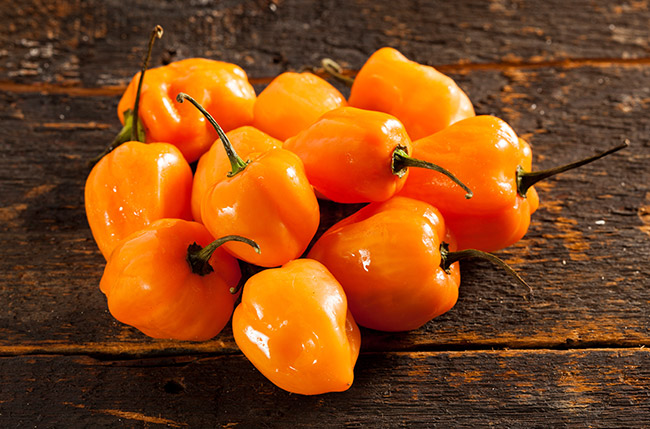
The habanero is a remarkably hot chile, it is a member of the plant species Capsicum chinense, the same species as the Scotch bonnet pepper. The name habanero roughly translates to “from Havana.” It is believed that the pepper originated in Cuba before it was introduced in Mexico where it is immensely popular. The pepper is most commonly used in its orange and mature state, because the flavor of the pepper is at its peak when the chile is fully ripe. The heat of habaneros ranges from 100,000 to 300,000 on the Scoville scale, meaning that this chile is exceptionally hot, around fifty times spicier than jalapeños. There are some red habaneros known as Caribbean Reds that are quite a bit spicier than the orange variety. These score at around 500,000 Scovilles. A black variant of the habanero exists as well, and is also somewhat hotter than typical orange habaneros, registering at approximately 450,000 Scoville units. Despite the immense heat of the habanero, the flavor of the pepper is quite sweet. The spicy chile has a fruity flavor and aroma that resembles apricot. Because of its fruity flavor, the habanero works well with tropical fruits like mango, and citrus fruits.
Because the habanero has a fruity flavor, it is often used alongside tropical fruits such as mango and citrus. Habaneros are an ideal ingredient in spicy chutney, or other fruit jellies. Habaneros are often used in salsas, because the flavor of the pepper works wonderfully with tomato. One of the most common applications of habaneros is as a marinade for seafood and pork. The chile can be used both fresh and dried. Drying and grinding the pepper into a powder makes it easy to add the sweet flavor and heat of the habanero to anything, and greatly extends its shelf life.
Fresh habaneros will have firm flesh and wrinkle-free skin. If the chile becomes limp and wrinkled, it should not be used. Habaneros will stay fresh for about a week, and are best kept at room temperature. When preparing habaneros, it is advisable to wear latex gloves, as the oils in the pepper can cause serious skin irritation. To reduce the spiciness of a recipe, while still retaining the sweet fruity flavor of the habanero, remove the seeds from the pepper. To do this, begin by cutting off the cap and stem of the pepper, and then cut the pepper lengthwise. Then use a spoon to scrape out the seeds and membranes and discard. It is always important to remember when dealing with spicy peppers to thoroughly wash your hands before touching your face, eyes or any other sensitive body parts, as the oils from the pepper can cause painful irritation.


 BACK TO PRODUCTS
BACK TO PRODUCTS